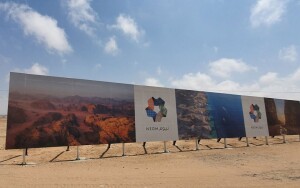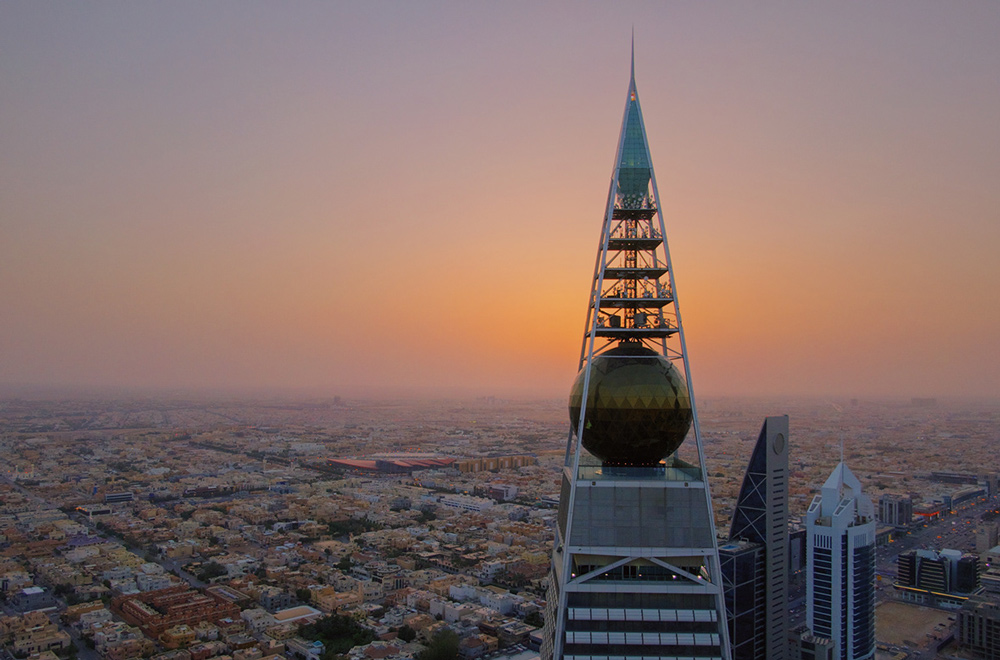My aim here is to venture a scholarly definition of the Continental Vibe, but allow me to arrive there via an anecdote, or an impression, really – one of my earliest memories of viewing the world as a cast of signs and symbols. A somersault of senses: visual, auditory, tactile, olfactory. A sum of building blocks and a bevy of pixels containing unique colour and tonal information that all come together to create reality.
Before fully conceptualizing it, it felt like reality was infinitely scalable. Endlessly re-sized larger or smaller with what felt like boundless file space and cloud storage, realized only through a set of interdependent variables: petrodollar, GDP, urban sprawl, vanity, ambition, and most importantly, an ontological hubris hellbent on conquering the world…
Reality, I nascently realized, was shaped by the way the architects of promise and potential model it, presented via a sea of blue tarps and barricades concealing construction sites, and experienced predominantly through sketches, two-dimensional images, 3D modeled saturated realness and corny saccharine expressions of the absolute: this was in my world the tallest, the first, the biggest, the most beautiful building in the world.
In 1994, British architectural firm Foster and Partners started construction on the first skyscraper in the Saudi Arabian capital, Riyadh. Al Faisaliah is a 267-meter-high tower including office spaces, a five-star hotel and a three-story luxury mall. The news circulated; the hype ballooned. The promise was to collapse time and space, bringing the world to downtown Riyadh.
Literally named ‘The Globe’, a gargantuan golden sphere twenty-four meters in diameter would hang under its pointy tip, and house a restaurant. The retail concepts trickled in: Harvey Nicoles, Debenhams, Tommy Hilfiger, DKNY – it made me sick with Dutch disease.
Al Faisaliah was framed as the first skyscraper in Saudi. Naturally, growing speculation matched its unprecedented height, a general apprehensiveness surrounding the forthcoming tower hanging over the city like a ghost. Naysayers and celebrators aligned in the obversely shared opinion that the project would act as an agent of major societal change, for better or worse.
This division sounds very familiar today. The skeptical-speculative axis, breeding anxieties and preaching restraint, as well as the hubristic camp, ever-sounding off the trumpets to yet another triumph for man vs. nature – these are hauntological binary positions, already locked and loaded, ready to be fired at any given battle against the unknown.
Yesterday, it was Al Faisaliah – today, it’s the metaverse.
The metaverse is peak Continental Vibe.
Essential to the Continental Vibe is this certain x-factor, an overwhelmingly ineffable node of incoherent forces that come together seamlessly under the experience economy to create value, both nominal and in capital terms. Value that subtly shifts the ‘vibe’ in minute particulate ways that are not quite graspable, but more like changes in the atoms in the air.
Some of the features that characterize the Continental Vibe are yellow ambient light, steel-glass facades, refracted silhouettes, a strong glow through amber bottles of perfume stacked two stories high, vitrines, overwhelming water fountains, the reflection of Mcdonalds’ golden arches on vast marble floors, wooden surfaces polished to formality, a strong sense of detachment from history, a mumblingly persistent present.
The Continental Vibe is somehow retro in style while feeling like a live digital render.
The Continental Vibe is a neologism coined by @afffirmations,[1] an Instagram meme account that promises Global Self Hypnosis, whose admin is a bored artist in Norway. The artist, who prefers to be referred to by his Instagram handle, gained popularity in the Gulf by sourcing architectural renders or stock footage of faceless figures and various urban views, to which he adds a hypnagogic aethereal twist and then overlays the visual with affirmative texts, like:
‘I AM DREAM LIFE’, ‘JUNE IS THE BEST MONTH’, ‘I THRIVE AT THE OFFICE’
The Continental Vibe should not be conflated with Gulf Futurism,[2].
The Continental Vibe is the phase that precedes Gulf Futurism. It’s the embryo that’s not always delivered. It’s the mood board that grants cohesion-despite-heterogeneity. In some cases, the Continental Vibe lives and dies in the render, a conceptual stillbirth. The Continental Vibe is both the promise of the project and the disappointment that ensues. It’s the rapture and the horror.
Gulf Futurism houses the ambition, while the Continental Vibe releases it from constraint.
Gulf Futurism represents the materiality possessed by the physical world that you and I live in: its UN accords and laws of physics. The Continental Vibe, however, stands for the quasi-‘immateriality’ that belongs to the metaphysical.
The Continental Vibe is what you get when you get nothing.
In an essay penned by Qatari-American artist Sophia Al Maria in her 2018 book Sad Sack, she captures this ungraspable nature of the Continental Vibe: “You need to know that the Arabian Gulf is a ridiculous place of unique possibility and I believe the ley lines of our global fate criss-cross the Gulf as tightly as the flight paths that transit through its hubs.” She continues:
It is an ersatz place of extreme chance. It is one of the most diverse places on the planet. The meeting point of Africa and Asia. Where else might you enter a restaurant to find a banquet table of Nigerians and Chinese eating Yemeni mandi together? Where else might you go to an Iranian Night Club atop a 1970s hotel and be served Red Label Jack Daniels by Ethiopian men in bow ties and dance on stage with Omani drag queens? … The Gulf appears Borgesian in its perfect ironies, wild juxtapositions and baroque bureaucracy. To most people its machinations are mysterious, cloaked behind an opaque curtain of cultural difference and this is the reason that all most people see when they look is the cold glimmering folly of nouveau riche hubris.[3]
Gulf Futurism is the cold glimmering folly – the Continental Vibe is the mysterious machinations.
Enter the metaverse, which can really only be conceived of via this relentless world-building. In October 2017, NEOM was announced, a future planned city in north-western Saudi Arabia, which would incorporate smart city technologies and function as an overt tourist destination, covering a total area of over 26,500 square km and extending 460 km along the coast of the Red Sea. Plans call for robots to perform functions such as security, logistics, home delivery, and caregiving. The name ‘NEOM’ is constructed from two words: the first three letters form the Ancient Greek prefix Neo– meaning “new”; the fourth letter is from the abbreviation of mustaqbal, Arabic for “future.”
Since its announcement, NEOM renders and high-resolution photography have captured the world by storm. My favourite are stock images flung around present-day desert NEOM depicting future desert NEOM.
 Advertisement in the NEOM Region in Tabuk, Saudi Arabia (Shutterstock)
Advertisement in the NEOM Region in Tabuk, Saudi Arabia (Shutterstock)
NEOM is a metaverse and the metaverse is high Continental Vibe.
Jean Baudrillard wrote about how reality is defined by simulation and illusion. As we technologically advance in our capacity to recreate realities, we assume the role of gods and therefore extinguish the definitive illusion. The simulation today is realizing so much, too much – there’s a suffocating excess of reality.
The radical illusion of the world, however, can never be extinguished. Reality needs it to maintain itself. The real existential risk is that the world comes to an end when “perfect understanding” is achieved, marking the point where the simulacrum reaches an apex. The world of ambiguity, illusion, mystery and imagination is essential – as soon as that ends, we’ll be non-autonomous robots living a determined existence. A living death.
Without falling into the familiar trap of viewing the metaverse through the aforementioned binaries of ultimate bearer of doom or utopian answer to society, without putting it through the test of success (Gulf Futurism) or failure (Continental Vibe), I propose a nuanced reaction. Digital technology really is as complex and perplexing as asking if humans are good or bad, isn’t it?
So I’ll leave off with a provocation at the risk of sounding technophobic: Baudrillard famously hated The Matrix series of films. He said that The Matrix is a film that The Matrix would make. If you want a world with the promise of liberation, one that truly proposes solutions rather than recycling the ghosts of increasingly disavowed market dynamics, ask less how it’s made, and more: Who made it? Put otherwise, ask less how real it seems, and more: Where’s the illusion?
–
Notes
[1] @afffirmations
[2] A term coined by the Qatari-American artist, writer, and filmmaker Sophia Al Maria.
[3] Sophia Al Maria, Sad Sack (London: Bookworks, 2018).
